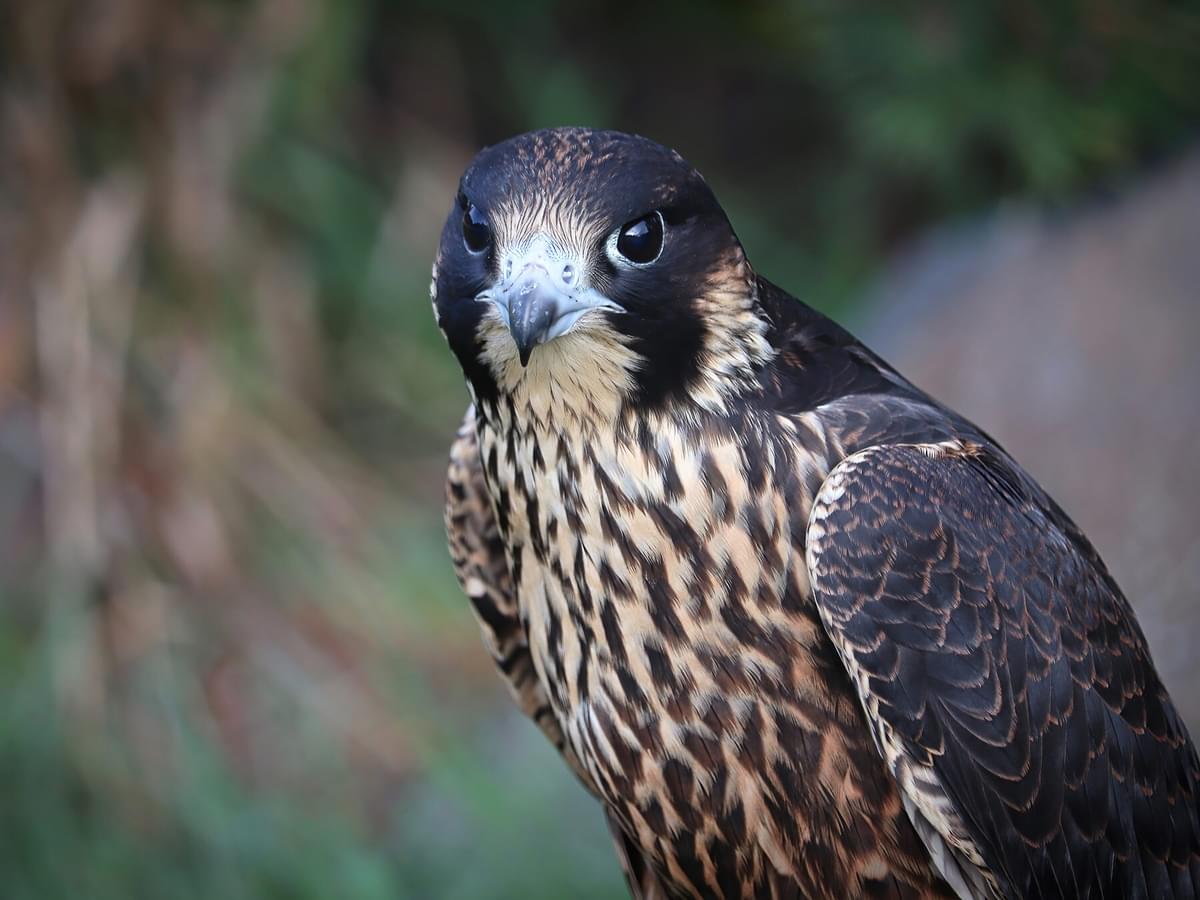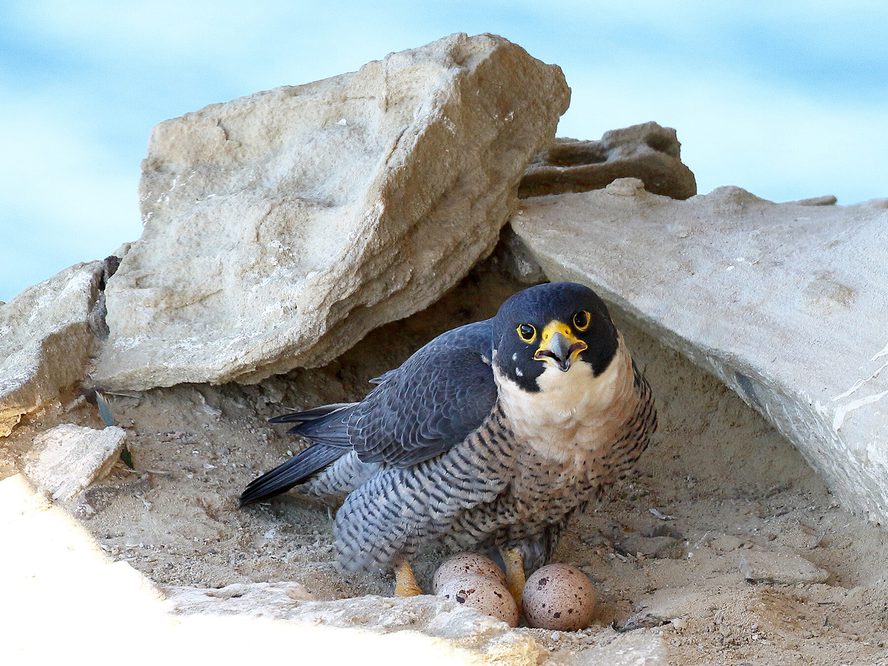Jump to Section
Juvenile Peregrine Falcons (Identification Guide with Pictures)
Last updated: 7 September 2022

Peregrine falcons have an incredibly diverse range that spans every continent except Antarctica. They live in practically every habitat, ranging from rainforests to mountains and arid deserts.
Peregrine falcons are not just highly adaptable, they’re also talented hunters and rank as the fastest animal on the planet, with a dive speed of some 186mph (300kph) or more. These birds live life in the fast lane, and many don’t make it to advanced age.
Some 17 to 19 subspecies of Peregrine falcons are distributed across much of the world, which makes identification exceptionally tricky - especially regarding juveniles! This is a guide to juvenile Peregrine falcons.
What do juvenile Peregrine Falcons look like?
There is considerable diversity in Peregrine falcon plumage across their 17 or so subspecies, but juveniles do have a few things in common.
A juvenile Peregrine falcon has fledged and is around 35 days old. Early juveniles are still very downy and often appear half-downed and half-feathered. They molt into their juvenile plumage over the winter.
Juvenile plumage tends to be brown with buff underparts. Barring is typically darker than adults with black stripes, which turn lighter during adulthood. Upper parts often have lighter edges than adults and are more strongly patterned with greater contrast in patterning, again becoming lighter and more uniform with adulthood, especially in the case of the American Peregrine falcon.
Juveniles also have darker “mustaches,” which extend vertically down the neck from the head. In addition, their facial area features duller yellow around the beak and eyes compared to the adult.
Overall, juveniles lack the largely blue/gray plumage, uniform pale-gray-to-white breasts, blue barred underparts, and uniform blue hoods that adults have. Instead, they’re more brown, rufous, or tawny overall.
Early juveniles also have fluffier, scruffier plumage, but this can become confused with molting adults.

What color are juvenile Peregrine Falcons?
Juvenile Peregrine falcons are largely brown, with barred brown underparts that feature contrasting dark-brown-to-black stripes. They also have lighter-tipped wings and sometimes have darker mustaches on the face.
Juveniles are generally:
- a) more brown and
- b) darker than adults, with bolder stripes and patterning
That’s probably the most reliable rule of thumb for telling them apart from adults. In addition, they largely lack the blue upper parts and hood of adult Peregrines.
How big are juvenile Peregrine Falcons?
Young Peregrine falcons grow quickly. They double in mass after just five days. By the time they fledge after 40 days or so, young Peregrines are a similar size and weight to adults, which are 38 to 48cm long with a wingspan of 95 to 110cm.
Peregrines grow quickly; by the time a Peregrine is two or three months old, they’re almost near-impossible to tell apart from an adult in size and weight.

A young Peregrine Falcon in its natural habitat
What do juvenile Peregrine Falcons eat?
Adult Peregrine falcons have a diverse diet that consists of many terrestrial animals. They’re carnivorous and solely eat meat.
Juvenile diets are likely the same as an adult’s diet but usually consists of easier catches at first, until the young bird learns how to hunt competently. Young Peregrines beg for food for a month or so after fledging but start hunting their own prey shortly after leaving the nest.
Some studies find that parents seem to teach young to hunt and handle prey, including dropping deceased prey from height to simulate a moving target. However, some of these claims have been refuted by researchers that believe the adults release prey to avoid being mobbed by begging juveniles.
It’s generally agreed that birds of prey hunt by instinct instead of being taught by their parents, but there are a few exceptions, so it’s certainly plausible that adult Peregrines teach their young how to hunt.

Young Peregrine Falcon eating a pigeon
How long does Peregrine Falcon juvenile plumage last?
Juvenile Peregrine falcon plumage lasts around 16 months. They’ll molt three times in this period, transitioning from pre-juvenile down to juvenile plumage and finally adult plumage.
Adult Peregrines also undergo annual molts, which makes it tough to identify birds from their plumage. As plumage molts, it becomes discolored and ruffled, which sometimes leads to molting adults being confused with juveniles or even other raptors.
How old is a juvenile Peregrine Falcon?
Peregrine falcons are considered juveniles for around 16 months or so, at which point their juvenile plumage will be all but gone.
Peregrines reach sexual maturity after 1 to 2 years but usually won’t mate until their second year.

Juvenile Peregrine Falcon in flight
How long do juvenile Peregrine Falcons stay with their parents?
Juvenile peregrine falcons stay with their parents for around two months after fledging.
During this time, they’ll continue to beg their parents for food, and their parents will demonstrate their hunting abilities as the juveniles watch and practice flight.
Juveniles aren’t competent fliers for a couple of months, at least. You might be able to identify their clumsy flight compared to competent, mature adults.
After that, juveniles often stay close to their parents until the start of fall migration or the end of winter.

Adult Peregrine Falcon feeding recently fledged chick
Other differences between juvenile Peregrine Falcons and adults
Juvenile Peregrines still beg their parents after fledging. This continues for around 1 to 2 months, so you might be able to identify juveniles as they harass their parents for food.
In some cases, juveniles might even mob their parents after a catch and attempt to steal it. Other than that, there are few behavioral differences between juvenile and adult Peregrines.

Juvenile Peregrine Falcon perched on a branch
What other species look similar to juvenile Peregrine Falcons?
Peregrine falcons look similar to the Prairie falcon, Gyrfalcon, Merlin, and Sparrowhawk. Young Merlins look similar due to their blueish upper parts, which are a similar color to Peregrines. However, Peregrines are much larger than Merlins.
While the Prairie falcon is also a falcon, it's a lighter color than a Peregrine and lacks its bluish upper parts and hood. Gyrfalcons are also similar in size and stature but are much lighter, verging on white.
It’s worth mentioning that different subspecies of falcons often have different plumage. Unfortunately, this makes it tough to identify some of the rarer color morphs.

Juvenile Peregrine Falcon flying
What are immature Peregrine Falcons called?
There’s no specific name for immature Peregrine falcons. While they remain in the nest, they’re called nestlings, once they leave the nest, they’re called fledglings, and then they become juveniles and adults.
On this page
- What do juvenile Peregrine Falcons look like?
- What color are juvenile Peregrine Falcons?
- How big are juvenile Peregrine Falcons?
- What do juvenile Peregrine Falcons eat?
- How long does Peregrine Falcon juvenile plumage last?
- How old is a juvenile Peregrine Falcon?
- How long do juvenile Peregrine Falcons stay with their parents?
- Other differences between juvenile Peregrine Falcons and adults
- What other species look similar to juvenile Peregrine Falcons?
- What are immature Peregrine Falcons called?

